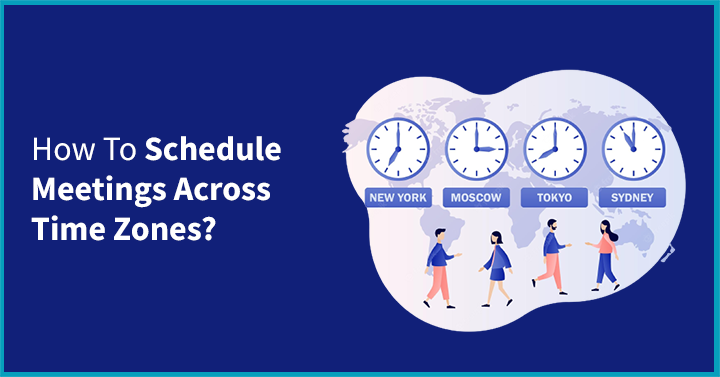Do you work with people who live in other time zones? Do you have trouble coordinating meetings around the clock? Meeting schedulers face the same challenges no matter where they are in the world. When people in different time zones are trying to schedule a meeting, the first thing they need to do is determine when everyone is available. Then they need to find a time that everyone can be in the same place at the same time. Some people prefer to hold meetings in the morning or evening so that everyone is in their natural time zone. Others may want to hold a meeting at night so that everyone is rested and refreshed for the day. No matter what time zone your participants are in, you can still schedule a meeting by using the following tips.

Here are 5 tips for scheduling meetings across different time zones:
If you’re like most people, you probably have at least a few colleagues or clients who are in different time zones. And if you’re in a global company, you may have team members in different time zones all over the world. Scheduling meetings can be a challenge, but there are a few things you can do to make it easier.
1. Know the time zones of your attendees
This may seem obvious, but it’s important to know the time zones of your attendees before you schedule a meeting. You can use a time zone converter to figure out the time difference between your location and the location of your attendees.
2. Schedule meetings during business hours
Try to schedule meetings during business hours, when people are more likely to be available. Keep in mind that business hours may be different in different time zones.
3. Schedule meetings in the middle of the week
If possible, schedule meetings in the middle of the week. Monday and Friday are often days when people are out of the office or have other commitments.
4. Consider the time of day
When you’re scheduling a meeting, consider the time of day. Morning or early afternoon may be best for some people, while others may prefer late afternoon or evening.
5. Use a meeting scheduling tool
There are a number of meeting scheduling tools that can help you schedule meetings across different time zones. These tools can be a great way to save time and make sure your meetings are scheduled correctly.
Scheduling meetings across different time zones can be a challenge, but it’s important to make sure your meetings are scheduled correctly. By following these tips, you can make sure your meetings are scheduled in a way that works best for everyone.
There are 4 options for scheduling meetings across time zones.
There are a few different tools that you can use in order to schedule meetings in different time zones. Four of the most popular ones are listed below:
1. Google Calendar
Google Calendar is a great tool for scheduling meetings in different time zones. You can simply create an event and then select the time zone that you want it to be in. Google Calendar will then automatically adjust the time of the event to match the time zone of the person who is viewing it.
2. World Clock
World Clock is another great tool for scheduling meetings in different time zones. It allows you to see the time in multiple time zones at once, which can be very helpful when trying to schedule a meeting. World Clock also has a built-in meeting scheduler that you can use to easily schedule meetings in different time zones.
3. Time Zone Converter
Time Zone Converter is a great tool for converting time zones. It can be very helpful when trying to schedule a meeting in a different time zone. Time Zone Converter can also be used to find out what time it is in multiple time zones at once.
4. Meeting Planner
Meeting Planner is a great tool for scheduling meetings in different time zones. It allows you to select the time zone of the person you are meeting with and then automatically adjusts the meeting time to match their time zone. Meeting Planner also has a built-in meeting scheduler that you can use to easily schedule meetings in different time zones.
Does Teams automatically convert time zones for meetings?
If you’re working with team members in different time zones, you may need to schedule meetings that accommodate everyone’s schedule. Fortunately, Teams can automatically convert time zones for meetings so that everyone can see the correct time on the meeting invite.
To do this, open the meeting invites and clicks the “More options” button. Then, click the “Convert time zones” button.
This will open a new window where you can select the time zone for each person invited to the meeting. Once you’ve selected the time zones, click the “Convert” button.
The meeting invite will then be updated with the correct time for each person’s time zone.
Keep in mind that this feature only works for meeting invites. If you need to convert time zones for other purposes, you’ll need to use a separate tool.
How does Teams know your time zone?
If you’re using Microsoft Teams to schedule meetings, you may be wondering how it knows your time zone. After all, if you’re scheduling a meeting with someone in a different time zone, you’ll need to make sure that the meeting is scheduled for the correct time in their time zone. Thankfully, Teams is designed to make this easy. Here’s how it works.
When you first create a Microsoft Teams account, you’ll be asked to set your time zone. This is so that Teams can correctly display the time for events and messages. Once your time zone is set, it can’t be changed.
If you’re scheduling a meeting with someone in a different time zone, Teams will automatically convert the time to their time zone. You’ll see both the local time and the time in the other person’s time zone next to the meeting time.
You can also set your own personal preferences for how you want to see time zones displayed. To do this, go to your Teams settings and select ‘General’. From here, you can choose to have all time zones displayed in 24-hour format, or to have the time zones displayed relative to your own time zone.
So there you have it! Now you know how Teams knows your time zone and how to schedule meetings in different time zones.
How do you manage a team in a different time zone?
If you have a team that’s located in a different time zone, there are a few things you can do to make sure everyone is on the same page (literally). Here are a few tips:
1. Set a schedule and stick to it.
This is probably the most important thing you can do. If you’re in the US and your team is in Europe, try to schedule all your meetings for 9am EST. That way, it’s 9am for you and 3pm for them. This will help prevent any confusion about what time it is for each person.
2. Use a tool like Calendly.
Calendly is a great tool that allows you to schedule meetings with people in different time zones. All you have to do is set up your availability and it will handle the rest.
3. Make sure to communicate clearly.
This one seems obvious, but it’s important to make sure that everyone is on the same page when it comes to time zones. If you’re unsure about something, always ask.
4. Have a plan B.
There will be times when things don’t go as planned. Maybe there’s a power outage in one of the time zones or someone’s internet goes down. It’s important to have a backup plan so that you can still communicate with your team.
5. Be flexible.
At the end of the day, you have to be flexible when it comes to managing a team in a different time zone. Things will come up that you can’t control, so it’s important to be able to roll with the punches.
How do you deal with time zone differences in the workplace?
“How do you schedule meetings in different time zones?”
This is a question that often comes up in the business world, especially for companies with a global reach. There are a few different ways to handle time zone differences when scheduling meetings, and the best method may vary depending on the company’s needs.
One option is to schedule all meetings in the local time zone of the person who will be leading the meeting. This eliminates the need for anyone to make adjustments to their schedule, and ensures that everyone is on the same page. However, this method can be difficult to coordinate if the meeting participants are in different time zones, as someone will always have to adjust their schedule.
Another option is to use a web-based meeting scheduler that takes into account different time zones. This can be a great option for companies with employees in different parts of the world, as it ensures that everyone can see the meeting time in their local time zone. There are a few different meeting schedulers available, so it’s important to find one that meets the needs of the company.
Finally, some companies choose to use a hybrid approach, where some meetings are scheduled in the local time zone of the person leading the meeting, and others are scheduled in a web-based meeting scheduler. This can be a great way to accommodate the needs of different employees, and to make sure that everyone can participate in the meeting.
No matter which method you choose, it’s important to be aware of the time differences between different time zones. This will help you to avoid any confusion or scheduling problems.



